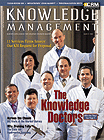Sidebar: Winners And Losers
Back to main article: The Importance of Knowledge Capital

Despite claims to the contrary, ownership of Knowledge Capital is highly concentrated
These findings reveal a gulf in the knowledge economy:
-
The top 100 firms among the 7,288 accumulated $5.6 trillion of Knowledge Capital of the total of $6.4 trillion or 88 percent of the total. These were all giant firms. This imbalance contradicts the popular theory that small firms account for the creation of new Knowledge Capital in the new economy. In fact, the large still rule wherever we look.
-
There were 3,917 firms (almost 54 percent of the total) whose Knowledge Capital was negative. In other words, they were worth less than their accounting valuations and worth more on paper than if they were auctioned off at “book value.” The sum of their negative Knowledge Capital was $2.0 trillion or 36 percent of the worth of the top 100 Knowledge Capital creators. This condition offers a strong argument against the proposition that the U.S. economy – during a period of unprecedented prosperity – may be approaching its capacity to generate wealth. Over half of the listed corporations appear to be searching for the bonanza of the new economy without finding it.
-
Translating these statistics into human terms, we discover enormous waste. The 3,917 firms with negative Knowledge Capital employed a total of 10.8 million persons or roughly 30 percent of the total number of employees in our sample. The average losing firm employed 2,757 people, and each of them was a liability, contributing negative Economic Value Added to the economy.
-
Contrast the Knowledge Capital poverty of the losers with that of the top 100 Knowledge Capital creators. Those firms employed 7.3 million persons or an average staff of 73,000. The Knowledge Capital per employee was worth $774,400. Each employee was a source of wealth in excess of the worth of his or her compensation.